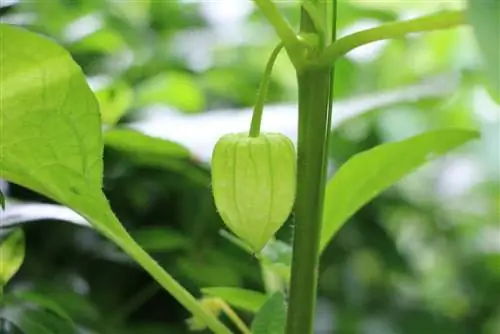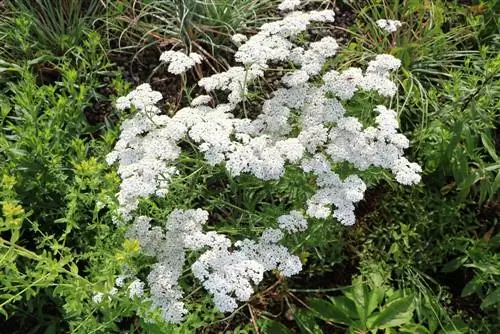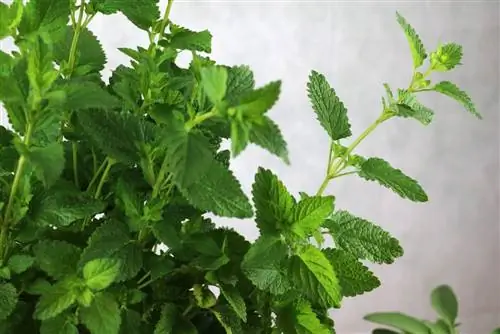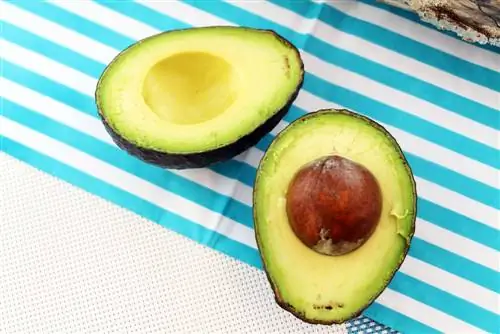- Author admin [email protected].
- Public 2023-12-17 03:39.
- Last modified 2025-01-24 12:45.
The decorative fruits of the Cape gooseberry or physalis are often used to decorate desserts, cakes or even cocktails. But the berry fruit can do much more, because it is very he althy, very rich in vitamins and, above all, delicious. Originally from Peru, the fruits are now mainly grown in South Africa. Due to its origin, it is also known as the Andean fruit. How he althy the fruit really is and what it can do is briefly explained in the following article.
Origin
The name Andean berry, as the physalis is also called, already reveals its origin. Because it originally comes from the highlands of Chile and Peru. The name Cape gooseberry also has an origin meaning. Portuguese sailors discovered the fruit in the 19th century and brought it to South Africa, where the plants spread around the Cape of Good Hope. Today the plants can also be found in local latitudes, with South Africa still being the main growing area for the fruits commercially available here.
The coated fruit
The name Physalis was given to the tasty fruit because its petals envelop it like a cloak during and after ripening. The petals grow together. When the fruit is ripe, the leaves look like dry, orange paper, which gives it the decorative appearance. However, the actual fruit is located in this shell as a small, red berry. This has a diameter of only one to two centimeters. Otherwise the Physalis has the following characteristics:
- Exterior very cute
- soft, very sticky shell
- Inside there are about 100-180 small, light-colored seeds
- these are also edible
- have an aromatic citrus flavor
- this combination makes it bittersweet to sour overall
Tip:
Physalis has an intense sour-sweet taste, which some connoisseurs compare with the taste of kiwi, gooseberry, pineapple or even passion fruit.
Drying Physalis
It's not just fresh fruits from South Africa that are sold in stores, which are mainly in season from December to July. Cape gooseberries are also increasingly being offered from local growing areas. Here they ripen between August and October. This means that ripe, fresh fruit can be accessed almost all year round. Once harvested, the physalis does not ripen and should therefore always be consumed immediately, otherwise it will spoil. Like grape raisins, the fruit is also suitable for drying and can be preserved in this way. When drying the fruit, the following must be taken into account:
- drying makes the outer skin almost transparent
- the seeds shimmer through the fibrous shell
- the water content is significantly reduced
- this is how it is preserved
- Nutrient density is retained through gentle drying process
- the taste can also be preserved this way
- Drying temperature must be 45° Celsius
- Put the fruit in an oven and adjust the temperature exactly
Tip:
After drying, the fruits should cool down well and then be stored in a dry and not too warm place. This means they have a long shelf life and can be used again and again in the kitchen.
Ingredients
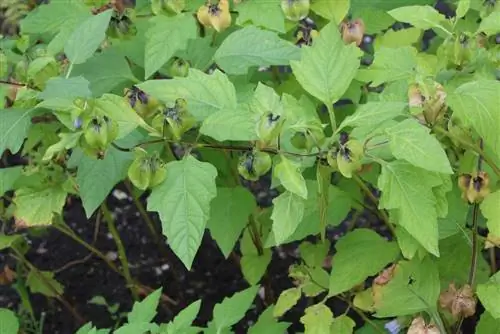
The low-calorie and low-fat Physalis develops its ingredients especially when fresh. However, it does not reach top values, but it does provide a good basis for a he althy diet. 100 grams of fresh fruit contains the following valuable vitamins:
- 0.06 mg vitamin B1
- 28 mg Vitamin C
- 0.04 mg vitamin B2
- 0.05 mg vitamin B6
- 0.5 mg vitamin E
- 8 µg folic acid
- 150 µg retinol
- 900 µg carotene
- 0, 1 µg biotin
- 2583 µg Niacin
- 0, 2 mg pantothenic acid
But it's not just the vitamins that make Physalis so attractive and he althy, the many minerals it contains also have a positive effect on the entire body when you enjoy the delicious berries. The following minerals are contained in 100 grams of Physalis:
- 5 mg sodium
- 170 mg potassium
- 10 mg calcium
- 8 mg magnesium
- 40 mg phosphate
- 1, 3 mg iron
- 0, 1 mg zinc
There are also 13 g of carbohydrates, 2 g of fiber and also protein with 2 g per 100 grams of fruit. With its 53 kilocalories, the physalis is also considered very low in calories.
Tip:
Physalis contains a lot of vitamin C, which the body needs for many metabolic processes. The fruits also contain a large proportion of beta-carotene, which is good for eyesight.
Vitamins and effects
Physalis contains many vitamins, all of which have a different effect and function on the human body and are therefore so he althy for humans when they work together.
Vitamin A

Even if only 30 grams of the delicious fruit are consumed daily, this already covers around 45% of the daily requirement for vitamin A. Vitamin A is made up of carotene and retinol. This is responsible for many functions in the body. This primarily includes strengthening the immune system and thus protection against illnesses and infections. In addition, vitamin A is said to have the following effects on the human body:
- Support vision at dusk
- for he althy mucous membranes
- good for treating various skin diseases, e.g. acne
- against viruses in the respiratory tract
- against measles
Vitamin B1
This vitamin is also called the anti-stress vitamin. Above all, it ensures a good and he althy nervous system and the muscle tissue and immune system are also strengthened and the body can better counteract stress-causing external factors. Anyone who doesn't consume enough vitamin B1 often suffers from irritability, fatigue, abdominal problems and even depression.
Vitamin B2
This vitamin is also called riboflavin and is primarily needed for he althy and stable hair, nails and skin. It is also required for the breakdown of fat, protein and carbohydrates. Anyone who suffers from a vitamin B2 deficiency can easily notice this through sensitivity to light, eye diseases, digestive problems and fatigue. When taken regularly, vitamin B 2 helps especially against:
- Cataracts, which cause cloudy vision
- Migraine, the frequency can be reduced up to 50%
Vitamin B6
Anyone who suffers from a vitamin B6 deficiency is often affected by irritability, depression and even confusion, and vitamin B6 anemia can also develop. Taken regularly, it helps the body support the following functions:
- forms antibodies that are necessary to fight diseases
- ensures normal nerve function
- forms hemoglobin
- breaks down proteins
- how to balance blood sugar
Vitamin C
Vitamin C is the best-known vitamin that primarily strengthens the immune system and thus offers better protection against viruses and bacteria. But the vitamin can do much more:
- Wounds heal better
- Cholesterol levels are lowered
- Cell life is extended
- Protection against cardiovascular diseases
- Protection against strokes
- Protection against cancer
- Production of collagen for firm skin
Tip:
According to a study, people who consume a lot of vitamin C have better skin. Wrinkles are less noticeable and age-related, dry skin can also be avoided.
Other ingredients and effects
As can be seen from the many ingredients and vitamins, physalis is an excellent source of vitamin C, niacin, phosphorus and beta-carotene. But above all, the high protein content, which is higher than the goji berry, which is known to be very high in protein, supports muscle building, stimulates cell growth and can therefore also be helpful in losing weight and dieting. The high phosphorus content, on the other hand, helps the body build teeth and bones and the energy from food can also be released better through the intake of phosphorus. This contained pectin, which is mainly found in local apples, and has the following effect:
- considered a natural gelling agent
- regulates digestion
- lowers blood sugar levels
- also lowers cholesterol levels
- bad cholesterol in particular is reduced by pectin
- the body's immune system and defenses are strengthened
- this can prevent the spread of cancer cells
Melatonin is also contained in the he althy berry. This has a stress-reducing effect on the human body, the biorhythm comes back into harmony and sleep disorders can also be eliminated in this way.
Against diseases

The Aztecs already knew the healing and beneficial effects of Physalis and used it against many diseases. It is now known that the fruit has a laxative effect when eaten in large quantities, especially due to the many small seeds inside, and is therefore often used against indigestion. If you regularly incorporate the delicious berries into your diet, you can achieve good intestinal flora. But there are other diseases for which the Cape gooseberry can be used to help. These mainly include:
- Diabetes
- toxins are eliminated due to the laxative effect
- Hepatitis
- Malaria
- can even be used to support various types of cancer
- Metabolic diseases
- Asthma
- Rheumatism
- Supporting the body's immune system
Tip:
Physalis can be incorporated into the menu every day. They can be eaten fresh or processed into a fruit salad or fruity smoothie. Dried, they are particularly popular in muesli or in homemade muesli bars.
External use
Physalis can also be used externally; it has a beneficial and healing effect, especially on skin irritations, wounds and inflammations of the skin. There are already tinctures with the active ingredients of the fruit on the market.
Conclusion
If you regularly incorporate Physalis into your diet, you can expect more energy. The berries support cell metabolism and thus ensure good well-being. The body's energy level is increased and mental performance increases. In addition, it stabilizes blood sugar and protects against cell damage. This cell damage is primarily caused by external factors such as the environment, industrial waste, smoke and exhaust gases as well as food and can lead to he alth problems. This cell damage can be counteracted by regularly consuming he althy Physalis with its antioxidants. The fiber also helps to keep cholesterol and blood sugar at a constant level and at the same time signals to the stomach that you feel full for longer. The delicious Physalis are not only very he althy and support the body in its own functions, but can also help you lose weight. If the fruits are included in the daily menu, whether dried or fresh, well-being is increased and many diseases are counteracted from the outset.

